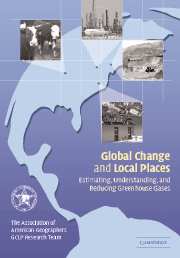Book contents
- Frontmatter
- Contents
- List of contributors
- Foreword
- Preface
- Acknowledgments
- Part One Global change and local places
- Part Two Learning from localities
- Part Three Beyond Kyoto I: greenhouse gas reduction in local places
- 7 Changing places and changing emissions: comparing local, state, and United States emissions
- 8 Explaining greenhouse gas emissions from localities
- 9 Attitudes toward reducing greenhouse gas emissions from local places
- 10 Reducing greenhouse gas emissions: learning from local analogs
- Part Four Beyond Kyoto II: greenhouse gas reduction potentials and strategies
- Index
- References
8 - Explaining greenhouse gas emissions from localities
Published online by Cambridge University Press: 31 July 2009
- Frontmatter
- Contents
- List of contributors
- Foreword
- Preface
- Acknowledgments
- Part One Global change and local places
- Part Two Learning from localities
- Part Three Beyond Kyoto I: greenhouse gas reduction in local places
- 7 Changing places and changing emissions: comparing local, state, and United States emissions
- 8 Explaining greenhouse gas emissions from localities
- 9 Attitudes toward reducing greenhouse gas emissions from local places
- 10 Reducing greenhouse gas emissions: learning from local analogs
- Part Four Beyond Kyoto II: greenhouse gas reduction potentials and strategies
- Index
- References
Summary
The Global Change and Local Places project case studies foster robust explanations of local, national, and international trends in greenhouse gas emissions. Knowing the specific events and processes responsible for changes in greenhouse gas emissions in particular places (sometimes called the proximate or intermediate forces of human-induced changes in the global environment) broadens understanding of possibilities for abatement or adaptation. Examples of proximate forces include the opening of a coal-fired power plant, or the growth of two-earner households and associated increases in automobile use. Proximate forces cannot be studied in isolation from the social processes that underlie them, the mechanisms and trends often called the driving forces of global change. Focusing on proximate forces and driving forces deepens understanding of greenhouse gas emission dynamics by emphasizing the degree to which the proximate forces that are so often the focus of policy responses are themselves determined by powerful social forces that policy makers often ignore.
The four Global Change and Local Places study areas were used as natural laboratories for teasing out details regarding the operations of proximate and driving forces. Case studies often provide contexts in which analysis and explanation are less refractory than they can be over larger areas (Box 8.1). Indeed, the distinctly different trajectories of greenhouse gas emissions for the four Global Change and Local Places study areas illustrate the ways emissions and changes in emissions over time vary in response to the different kinds of economic change that have occurred in the four areas.
- Type
- Chapter
- Information
- Global Change and Local PlacesEstimating, Understanding, and Reducing Greenhouse Gases, pp. 158 - 170Publisher: Cambridge University PressPrint publication year: 2003



